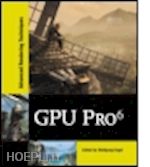I: GEOMETRY MANIPULATIONDynamic GPU Terrain; David PangerlIntroductionOverviewTerrain DataRenderingDynamic ModificationPhysics SynchronizationProblemsConclusionsBandwidth Efficient Procedural Meshes in the GPU via Tessellation; Gustavo Bastos Nunes and Joao Lucas Guberman RazaIntroductionProcedural Mesh and the Graphics PipelineHull ShaderDomain ShaderNoise in Procedural MeshesPerformance OptimizationsConclusionBibliographyReal-Time Deformation of Subdivision Surfaces on Object Collisions; Henry Schafer, Matthias Nießner, Benjamin Keinert, and Marc StammingerIntroductionDeformable Surface RepresentationAlgorithm OverviewPipelineOptimizationsResultsConclusionAcknowledgmentsBibliographyRealistic Volumetric Explosions in Games; Alex DunnIntroductionRendering Pipeline OverviewOffline/Pre-ProcessingRuntimeVisual ImprovementsResultsPerformanceConclusionAcknowledgementsBibliographyII: RENDERING Next-Gen Rendering in Thief; Peter Sikachev, Samuel Delmont, Uriel Doyon, and Jean-Normand BucciIntroductionReflectionsContact-Hardening ShadowsLit ParticlesCompute Shaders-Based Post-ProcessingConclusionAcknowledgmentsBibliographyGrass Rendering and Simulation with LOD; Dongsoo Han and Hongwei LiIntroductionRender Grass BladesSimulationResultsBibliographyHybrid Reconstruction Anti-Aliasing; Michael Drobot IntroductionOverviewRelated workHybrid Anti-Aliasing OverviewTemporally Stable Edge Anti-AliasingTemporal Super SamplingTemporal Anti-aliasing (TAA)Final ImplementationResults DiscussionConclusionBibliographyReal-Time Rendering of Physically-Based Clouds Using Precomputed Scattering; Egor Yusov IntroductionLight Transport TheoryPre-computed SolutionsVolume-Aware BlendingImplementationResults and DiscussionConclusionBibliographySparse Procedural Volume Rendering; Doug McNabbIntroductionOverview of Current TechniquesOverviewMetavoxelsAlgorithmConclusionBibliographyIII: LIGHTINGReal-Time Lighting via Light Linked List; Abdul BezratiIntroductionAlgorithmPopulating the Light Linked ListAccessing the Light Linked ListReduced ResolutionConclusionBibliographyDeferred Normalized Irradiance Probes; John Huelin, Benjamin Rouveyrol, and Bart lomiej WronskiIntroductionDeferred Normalized Irradiance Probes AlgorithmTool Side of the AlgorithmRuntime Details of AlgorithmResults and DiscussionBibliographyVolumetric Fog and Lighting; Bartlomiej WronskiIntroductionVolumetric Fog AlgorithmResults and DiscussionBibliographyPhysically Based Light Probe Generation on GPU; Ivan SpogreevIntroductionLight Probes TheoryGenerating Light Probes on the GPUResultsBibliographyReal-Time Global Illumination Using Slices; Hugh Malan IntroductionAlgorithm OverviewApproximating the Irradiance Due to an Emissive PlaneBuilding the Image PyramidCombining Multiple SlicesLayered HeightfieldsSlice PlacementPropagating IrradianceResultsConclusionBibliographyIV: SHADOWS Practical Screen Space Soft Shadows; Márton Tamás and Viktor HeisenbergerPre-introductionIntroductionHistoryAlgorithm OverviewShadow Map Rendering PassIntroducing Layers, Light Assignment Layered Penumbra Map PassAnisotropic Gaussian Blur PassLighting PassPerformance ConsiderationsResultsQuality TestsPerformance AnalysisConclusionBibliographyTile-Based Omnidirectional Shadows; Hawar Doghramachi IntroductionOverviewImplementationResultsDiscussionConclusionBibliographyShadow Map Silhouette Revectorization; Vladimir BondarevIntroductionImplementationResultsFuture WorkConclusionBibliographyV: MOBILE DEVICESHybrid Ray Tracing on a PowerVR GPU; Gareth MorganReviewCombining Ray Tracing with RasterizationHard ShadowsSoft ShadowsReflectionsTransparencyPerformanceResultsConclusionBibliographyImplementing a GPU-Only Particles Collision System with ASTC 3D Textures and OpenGL ES 3.0; Daniele Di DonatoIntroductionGPU-Only particles systemPhysics SimulationRendering the ParticlesConclusionBibliographyAnimated Characters with Shell Fur for Mobile Devices; Andrew Girdler and James L JonesIntroductionOverviewCreating a Shell Fur TextureBone Batches or Single Pass?Model Data and SetupAnimation with TFInstancing for Fur ShellsLighting and Other EffectsConclusionBibliographyHigh Dynamic Range Computational Photography on Mobile GPUs; Simon McIntosh-Smith, Amir Chohan, Dan Curran, and Anton LokhmotovIntroductionBackgroundTone Mapping OperatorsRelated WorkGPGPU using OpenCLOpenGL ES and AndroidImplementing an HDR Pipeline using OpenCL and OpenGL ESAndroid ImplementationPerformance of our HDR effectsConclusionsBibliographyVI: COMPUTECompute-Based Tiled Culling; Jason StewartIntroductionOverviewImplementationOptimizationUnreal® Engine 4 ResultsConclusionAcknowledgmentsBibliographyRendering Vector Displacement Mapped Surfaces in a GPU Ray Tracer; Takahiro Harada IntroductionDisplacement MappingRay Tracing a Scene with Vector Displacement MapsRay Tracing a Vector Displacement PatchIntegration into an OpenCL Ray TracerResults and DiscussionConclusionBibliographySmooth Probabilistic Ambient Occlusion for Volume Rendering; Thomas Kroes, Dirk Schut, and Elmar EisemannIntroductionSmooth Probabilistic Ambient OcclusionApproximating Ambient OcclusionResultsConclusionBibliographyVII 3D ENGINE DESIGN Blockwise Linear Binary Grids for Fast Ray Casting Operations; Holger Gruen OverviewIntroductionBlock-Wise Linear Memory LayoutRendering Block-wise linear Binary Voxel GridsCasting Rays Through a Block-Wise Linear GridDetecting Occlusions During Indirect Light GatheringResultsFuture WorkExternal ReferencesBibliographySemantic Based Shader Generation Using Shader Shaker; Michael Delva, Julien Hamaide, and Ramses LadlaniIntroductionPrevious WorkDefinitionsOverviewAlgorithm ExplanationError ReportingUsage DiscussionsWhat's nextConclusionBibliographyANGLE: Bringing OpenGL ES to the Desktop; Shannon Woods, Nicolas Capens, Jamie Madill, and Geoff LangIntroductionDirect3D 11Shader TranslationImplementing ES3 on Feature Level 10Future Directions: Moving To New PlatformsRecommended PracticesBibliography












